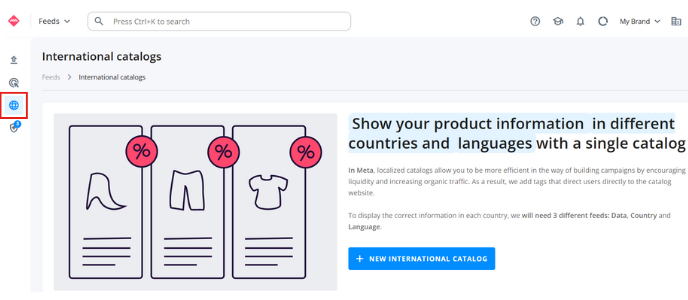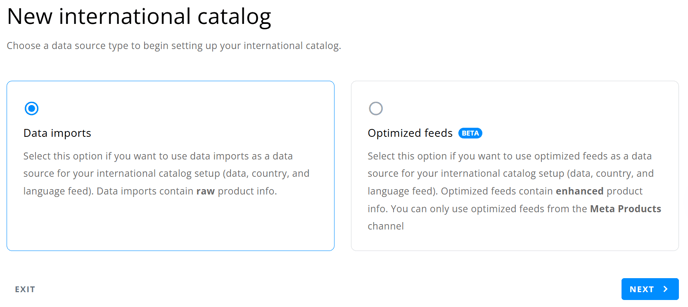Create International Catalogs with localized information
Showcase your products to the right person, in the right language and currency

With International Catalogs feature, you can manage your entire catalog in one single multilingual and multi-currency feed, removing the need to create a separate catalog for each country or language. This setup helps streamline your catalog strategy and ensures a more consistent and scalable approach for global audiences.
International catalog lets you host all product information in a centralized structure while layering localized versions of product titles, descriptions, pricing and availability on top. Meta will automatically detect a user's location and show them the most relevant version of the product, enhancing the shopping experience and improving conversion rates.
By using AMP to build your international catalog, you save time and reduce operational complexity, all while making sure your ads and product listings always feel local, no matter where your customers are.
Common Use Cases
- Instagram Shopping
Instagram Shop brings your brand's products closer to the end user. It allows you to tag products in photos and videos on feed and stories, as well as create an interactive store within your Instagram brand profile.
By creating an International Catalog and connecting it to your organic Instagram profile, you can tag products and showcase your catalog organically in multiple languages. Once your store is approved by Meta, you can tag products in posts, reels, and stories — providing a seamless shopping experience that automatically adapts to each user's location and preferences.
See here Instagram’s requirements to activate Instagram Shopping for your business.

- Multi-country catalog campaigns
International Catalogs allow you to simplify your campaign structure, especially when running one catalog per market, by consolidating everything into a single catalog to serve ads across multiple countries and languages. This not only saves time but also leads to better budget optimization and improved campaign performance, as Meta can more efficiently allocate spend based on where the highest returns are.
Meta will automatically serve the correct localized version of each product based on the user’s country and language settings, without needing to split campaigns or duplicate assets.
How to create an International Catalog in AMP
- Data Imports provide raw product information directly from your eCommerce platform, meaning the data will be displayed exactly as it is received.
- Optimized Feeds offer enhanced and enriched product information, allowing you to add layouts or modify, add, or remove product details for better customization of your catalog content.
Keep in mind that using the Optimized Feeds option to nurture International Catalogs is only available through the Meta Products channel output.

The process of creating your International Catalog is the same regardless of which data source you choose. Follow these steps:
-
Name your International Catalog and Select your Data Base Feed
This catalog will serve as the base feed. This selection will determine the total number of products available in the International catalog and also defines the fallback information that will be displayed in case the localized version (country or language) is not available. -
Select the countries
Select all the countries for which you want to add country-specific fields, such as:-
price -
sale_price -
link -
size -
currency
-
-
Select the languages
Pick the languages in which you want to add localized content, based on the languages specified in your Data Imports. This will enable you to translate:-
title -
description
-
Verify that the Data Imports follow Meta's standard country and language codes as specified here
Once the setup is complete, click Save and update your catalog. Once processed, you will have a localized catalog and three feed URLs will be generated automatically:
-
Data Feed URL
-
Country Feed URL
-
Language Feed URL
Set up in Commerce Manager
Once your International Catalog is ready and the three feed URLs are generated, uploading them to Meta Commerce Manager is straightforward:
-
Go to Commerce Manager and select your catalog or create a new one. It's important that the brand is the owner of this catalog, it should never be owned by agency or third party.
-
Under Data Sources, upload your main feed (Data Feed URL) and configure the default language and currency.

-
Next, in Country and language feeds section, upload your country and language-specific feeds providing the corresponding URLs. Meta will match the localized content using the ID field.

-
To check how an item's information will appear for a certain country or language, go to Items > click on a product > click on International Coverage tab to verify the localized information for each market and language.

- We recommend scheduling each feed to refresh daily and to run a full update once a week, which will also remove any discontinued products. You can set this up in the Catalog settings section, under 'Schedule'.

- Make sure that a default language and country is set for your base catalog. You can do this in the Commerce Manager under Settings > General
Considerations on how Meta handles localized data
- Localized country and language feeds are complementary to your main feed. They enrich product information with translations, pricing variations, and market-specific availability.
- Each product must share the same ID across all feeds. This enables Meta to associate localized information with the correct product.
- If only some items have localized versions for a country, Meta will only display those products to users in that country. For example, if all your catalog items have French data except for one handbag, French users will see all products except the missing handbag.
- If your catalog doesn’t contain any localized data for a specific country, Meta will simply show the default (main feed) version. For example, if you have no Japanese content, Japanese users will see the US version of your catalog.
- If an item is out of stock in a specific country, mark it as such in the relevant localized feed. That product will be excluded from ads in that country, but will still appear in the shop — marked as out of stock. You can also remove the item entirely from that country’s feed if needed.
- If you delete an item from the main feed, its localized data is preserved. If you later re-add the product to the main feed, its localized data will automatically be re-linked. However, if you don't plan to bring the product back, we recommend removing it from the localized feeds as well.
Check out more tips for managing localized catalogs here
Connect your catalog to Instagram Shop
Finally, to connect this catalog created in Commerce Manager with the brand's Instagram account to be able to tag products on images, we must be logged in from the mobile to that account in the Instagram application and follow these steps:
- Go to Account Settings
- Go to Shopping
- Select the catalog that we have created from Commerce Manager